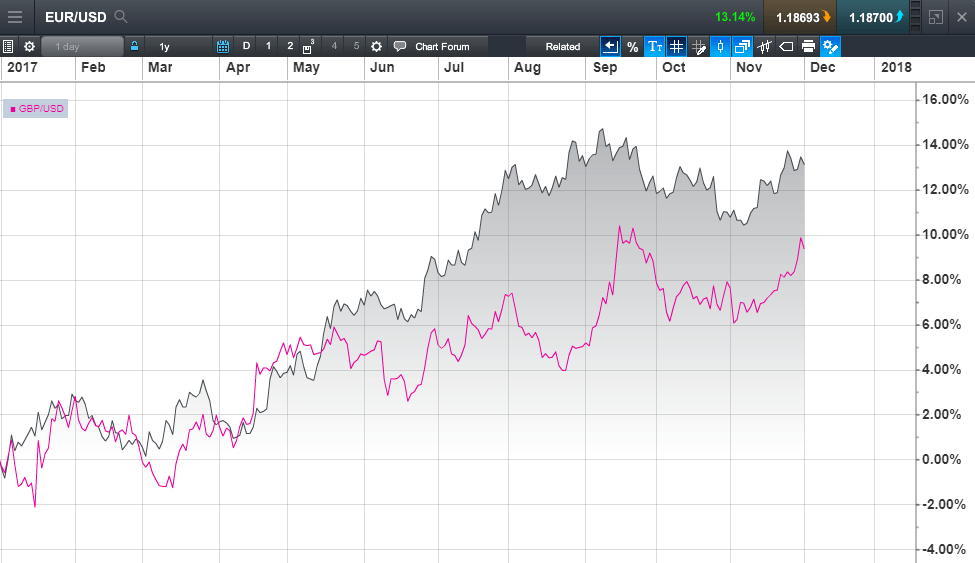2016 was a good year for the FTSE100, DAX and S&P500 with gains of around 10% for all three, with all the gains coming in the second part of the year, mainly as a result of a weaker euro and pound. Given the turbulence of 2016, expectations coming into 2017 were more tempered given concerns about the resilience of European banking sector, which still remains far from fixed no matter what certain European politicians would have you believe.
Populism was also in the ascendancy on the back of President Trump’s win in the US election and the aftermath of the Brexit vote, as elections in the Netherlands, France and Germany loomed. This may have partly influenced the ECB’s decision at the end of 2016 to extend its asset purchase program to the end of 2017, albeit by tapering the monthly amount lower to €60bn starting in April 2017.
On the flip side of that, there was an enormous amount of optimism that the new US President would be able to deliver on his pledges to cut taxes, regulation, as well as delivering on fiscal boost to the US economy, which was fuelling speculation of capital repatriation into the US dollar and could prompt a faster tightening cycle from the US Federal Reserve.
In any event the concerns about Europe proved to be misplaced with an improving economic outlook as well as a modernising new French President who swept away all before him to take the Elysee Palace with ease albeit on a very low turnout.
There were some ruptures as Spain found out with the crisis in Catalonia, which prompted concerns about the integrity of the country, while the inability of German politicians to agree on a new coalition government after the September elections has introduced a paralysis of policy at the top of European politics.
In the UK article 50 got triggered at the end of March as expected, however, things got much more complicated in June after the inconclusive snap election called by Theresa May in April saw the Conservatives lose their slim majority, as a resurgent Labour Party recovered some of its lost mojo under the populist policies of Jeremy Corbyn.
Over in Asia the problems on the Korean peninsula flared up again as North Korea fired off several long range missiles over Japan and conducted a series of nuclear tests. Despite this, the Nikkei225 has been one of the best performing indices this year along with the S&P500.

Source: CMC Markets
Despite all of this, equity markets continued where they left at the end of 2016 as economic data from across the globe showed strong signs of picking up and accelerating with both soft and hard data indicators posting numbers of varying degrees, coming in at multi year highs. The Nikkei 225 and S&P500 led the way higher, though as we head towards year end we are starting to see some evidence that the current rally is starting to get tired, and this could take some gloss off the current gains.
European markets appear to be leading this trend, starting to diverge away if we look closely at the DAX and EuroStoxx50. They could be about to roll over despite their impressive gains so far this year after their peaks in November.
Part of this is probably down to a rising euro which, along with the pound, has outperformed the US dollar this year. If this trend continues then markets in Europe could still lag behind in 2018.

Source: CMC Markets
As in 2016, markets got off to a slow start with most of the gains coming in the second part of the year, with the Nikkei 225 hitting its highest levels since 1996, while the DAX, S&P500 and FTSE100 all posted new record highs.,The FTSE100 has been a bit of a laggard overall, lagging well behind the FTSE250 which is up 9% so far year to date.
As we come to the end of 2017, the same investor concerns that had been prevalent at the end of 2016 have continued to be prevalent, especially as the Trump scorecard from the beginning of the year still remains unmarked. No fiscal boost, no changes to bank regulation and no changes thus far in the tax code, which makes zero out of three, one year into his presidency. As report cards go, its bottom of the class stuff.
What we can look forward to is a US central bank that has undergone a significant upheaval at the top, a new leader in Jerome Powell, as well as the prospect of at least another four new appointments. We’ve already seen two Trump appointees in the shape of Randal Quarles as vice chair for bank supervision, and Marvin Goodfriend, both of whom we know relatively little about.
Mr Quarles has warned about risks to financial stability from bitcoin and other cryptocurrencies, while other public utterances would appear to suggest he favours taking a fresh look at current banking regulations, something new Fed chair Jerome Powell has also suggested might be worthwhile.
There has been some speculation that Mr Goodfriend might well lean to the more hawkish side when it comes to interest rates, given Donald Trump’s distaste for low rates before he was president.
This narrative has undergone a shift since he became president as several outbursts about the strength of the US dollar this year will testify. As such it would be surprising if the president were to knowingly pick a Fed board member who could then cause future problems for him by pushing the US dollar back up.
Other risks to consider are Italian elections which, if history is any guide, will probably be a damp squib given expectations around France and the Netherlands a year ago. That being said there is a much bigger eurosceptic fringe in Italy than elsewhere in Europe and the eurosceptic party 5 Star are ahead in the polls.
A slowdown in economic growth, as well as a continued failure to deal with the dysfunctional Italian banking system also remains a tail risk.
We shouldn’t forget the background noise of the Brexit talks as the talks look to progress to matters of trade. A breakdown in talks can by no means be ruled out, along with a collapse of the UK government which might bring about the prospect of an anti-business Labour administration, which could prompt a run on the pound and large scale capital outflows.
The material (whether or not it states any opinions) is for general information purposes only, and does not take into account your personal circumstances or objectives. Nothing in this material is (or should be considered to be) financial, investment or other advice on which reliance should be placed. No opinion given in the material constitutes a recommendation by CMC Markets or the author that any particular investment, security, transaction or investment strategy is suitable for any specific person.
Disclaimer: CMC Markets Singapore may provide or make available research analysis or reports prepared or issued by entities within the CMC Markets group of companies, located and regulated under the laws in a foreign jurisdictions, in accordance with regulation 32C of the Financial Advisers Regulations. Where such information is issued or promulgated to a person who is not an accredited investor, expert investor or institutional investor, CMC Markets Singapore accepts legal responsibility for the contents of the analysis or report, to the extent required by law. Recipients of such information who are resident in Singapore may contact CMC Markets Singapore on 1800 559 6000 for any matters arising from or in connection with the information.








